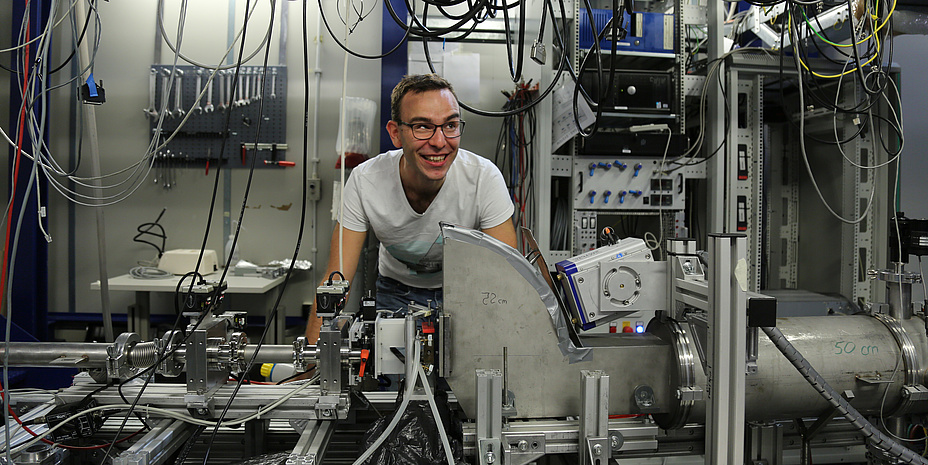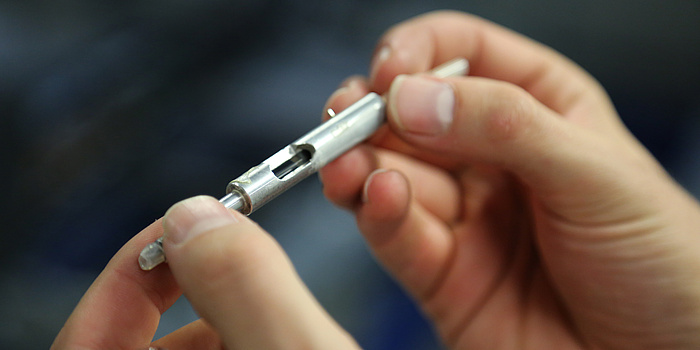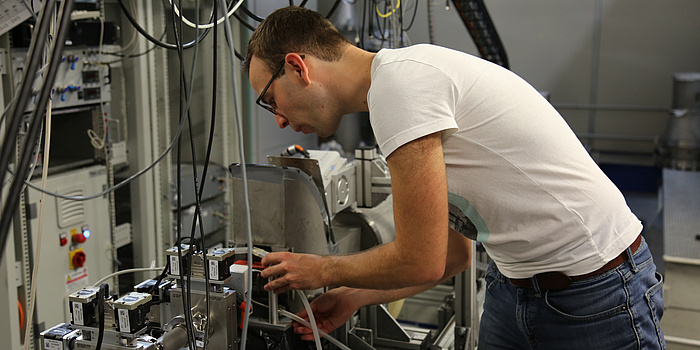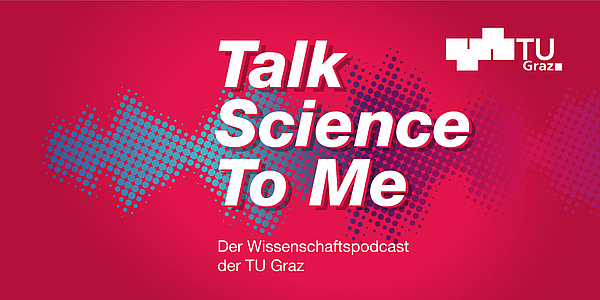Tools of the trade: super-fast electrons

In the silver office container, not even the chairs dare to make a squeak. Sitting on the nervy seat, Max Burian is looking at two small computer monitors. All around him, everything is quiet – a far cry from the concentrated flurry of activity of the past few minutes.
But let’s rewind a bit first: the office chair is getting a break as Max Burian is bent over some equipment in the laboratory section of the container. He is preparing a material sample on the beamline, which will shortly fire high-intensity light through the sample. The beamline is a metal pipe that only contains a vacuum. In a few moments, though, when Max presses the big red button on the wall, he will have to move fast. He has precisely 30 seconds to safely negotiate the two steps to the office part of the container and close the thick metal door that separates the beamline from his desk. Once the 30 seconds are up, the connecting hatch can be opened to the storage ring, where electrons whizz around in circles at almost the speed of light, giving off high-intensity light. The researcher uses this light to study the structure of a small material sample in a silver tube. “We rarely do things at a leisurely pace here,” says Max with a twinkle in his eye. He analyses a wide variety of samples: organic molecules, salt crystals and combined systems – basically anything, as long as it has a nanostructure.

Max Burian holds a tube containing material that has been prepped for an experiment. In a few minutes he will fire high-frequency light through the sample.
A synchrotron is a particle accelerator in which electrons move at close to the speed of light and emit light as a result. Researchers conduct this light in what are known as beamlines in order to carry out experiments on various organic and inorganic materials. An in-depth article on the functions of a synchrotron and the Elettra Syncrotrone Triest research facility is available at Planet research. TU Graz teamed up with the Italian facility in 2012 and operates two beamlines.
TU Graz team based in Graz and Trieste
Max deftly makes it up the steps and is back at his desk. The office chair is pressed back into service. He is surrounded by the rest of the team. You could hear a pin drop as they wait for the data to come through.
30-year-old Burian is part of a four-strong team from TU Graz’s Institute of Inorganic Chemistry working in the field laboratory at the synchrotron facility in Trieste. Heinz Amenitsch, the head of the research group, works with Burian on the SAXS beamline, where they mainly investigate reaction processes at high time resolutions. Benedetta Marmiroli and Barbara Sartori create structures to minute scales on the DXRL beamline. Besides TU Graz, another 26 research teams from across Europe, specialising in a wide range of test methods, operate beamlines. “We’re like a small family here, the atmosphere is good,” Burian says. And that seems to be essential, as the scientists are busy carrying out detailed research during the day, and often into the night, in a circular room packed with research equipment at the heart of the building.
An experiment becomes a long-term partnership
Born in Burgenland, Burian launched his scientific career at the University of Leoben, where he first used scattering as an investigative method. “I had to work the hardest on this topic – it was the most difficult one for me,” Max comments. “So I stuck with it.” During a joint experiment with the TU Graz team, the then student met gifted scattering expert Heinz Amenitsch. And the first experiment they conducted together grew into a long-term partnership. After completing his doctorate in Trieste, Max is now part of the team working on the SAXS beamline. .
From the office container to a fish restaurant
The researcher now lives in an apartment he owns close to the centre of the Italian port city. Trieste is a great place to live – and after work, the seaside is just a short trip away. Weather permitting, Max sometimes heads for the city’s beaches in the early afternoon. It’s all about recharging your batteries when you have the time, because the next night shift is probably just around the corner.
This evening, the scientists meet up in a fish restaurant. “Restaurants in Trieste come in various price categories,” Burian explains with a grin. “We call a EUR 30 meal the ‘gateway drug’. If you don’t eat fish regularly, you’ll be satisfied here. You can have a really good meal for EUR 50. And from EUR 70 upwards, you can eat like a gourmet.” On this particular evening, they choose the gateway drug for their guests at the Montecarlo restaurant on Via S. Marco: antipasti from the buffet, a primo of stuffed pasta and grilled salmon for secondo, with tiramisu for dessert – all served under a tent roof with electric heaters to protect against the chilly autumn evening air.
After dinner, it’s back up the hill overlooking Trieste where the synchrotron is located. They have no choice with the current experiment. “We have to be flexible. We can’t just stop taking measurements and start work again the next day,” Burian points out. Above all, they have to adapt to customers’ schedules and research requirements, which often allow only a few days for experiments at the synchrotron. Scientists come from research facilities all over Europe to make use of the powerful light source and work on their own projects. “I spend about 30 percent of my time preparing and managing experiments for others, 30 percent on my own research and 40 percent on maintenance and enhancing the beamline,” says Burian. “We really invest a lot of time in providing effective support to visiting researchers – that’s our USP. And of course, that involves going out for dinner, like this evening,” he laughs.
But now concentration is the order of the day once more: the data from the experiment have arrived and the evaluation can begin. Max Burian steps into the office container, where he will work long into the night. And his awestruck office chair will soon fall silent again.

If there are no experiments scheduled, Max Burian works on the beamline, carrying out maintenance and developing the equipment.
Visit Planet research or more research related news.
Kontakt
Max BURIAN
Dipl.-Ing. Dr.techn.
Institute of Inorganic Chemistry
34149 Basovizza (TS)
Elettra-Sincrotrone Trieste
Italy
burian@tugraz.at

![[Translate to Englisch:]](https://www.tugraz.at/fileadmin/_processed_/9/8/csm_banner-thek-by-privat_a42f57f7b3.jpg)


